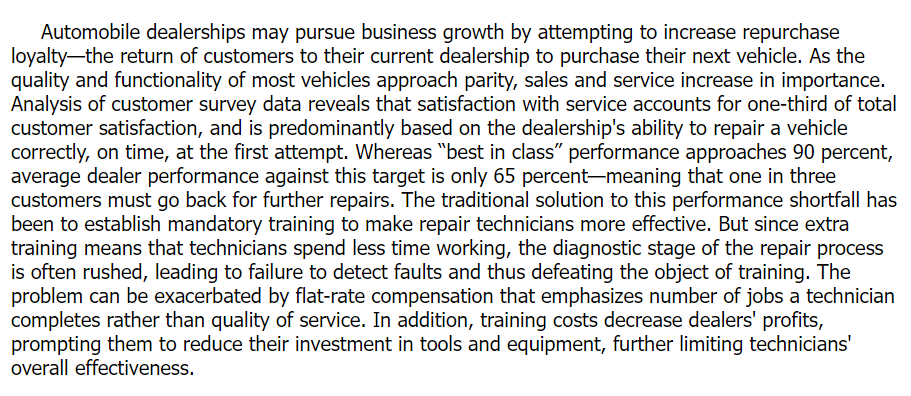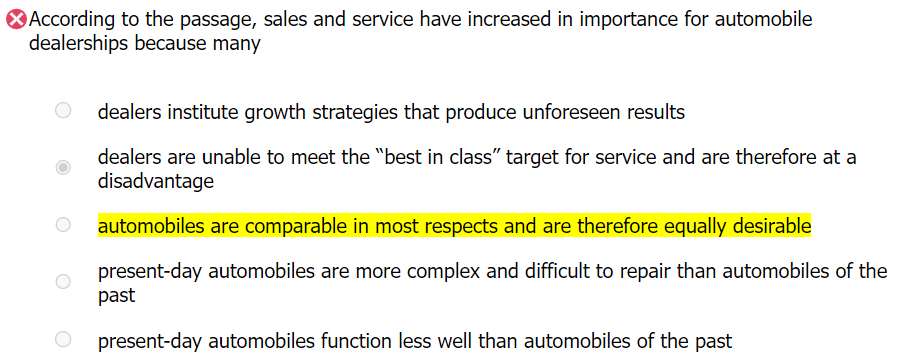Events & Promotions
|
|

GMAT Club Daily Prep
Thank you for using the timer - this advanced tool can estimate your performance and suggest more practice questions. We have subscribed you to Daily Prep Questions via email.
Customized
for You
Track
Your Progress
Practice
Pays
Not interested in getting valuable practice questions and articles delivered to your email? No problem, unsubscribe here.
- Nov 20
07:30 AM PST
-08:30 AM PST
Learn what truly sets the UC Riverside MBA apart and how it helps in your professional growth - Nov 22
11:00 AM IST
-01:00 PM IST
Do RC/MSR passages scare you? e-GMAT is conducting a masterclass to help you learn – Learn effective reading strategies Tackle difficult RC & MSR with confidence Excel in timed test environment - Nov 23
11:00 AM IST
-01:00 PM IST
Attend this free GMAT Algebra Webinar and learn how to master the most challenging Inequalities and Absolute Value problems with ease. - Nov 25
10:00 AM EST
-11:00 AM EST
Prefer video-based learning? The Target Test Prep OnDemand course is a one-of-a-kind video masterclass featuring 400 hours of lecture-style teaching by Scott Woodbury-Stewart, founder of Target Test Prep and one of the most accomplished GMAT instructors.
Kudos
Bookmarks
Question 1
C
Be sure to select an answer first to save it in the Error Log before revealing the correct answer (OA)!
Difficulty:
 35%
(medium)
35%
(medium)
Question Stats:
64% (02:22) correct 36%
(02:52) wrong
36%
(02:52) wrong  based on 420
sessions
based on 420
sessions
History
Date
Time
Result
Not Attempted Yet
Question 2
A
Be sure to select an answer first to save it in the Error Log before revealing the correct answer (OA)!
Difficulty:
 15%
(low)
15%
(low)
Question Stats:
78% (01:04) correct 22%
(01:12) wrong
22%
(01:12) wrong  based on 443
sessions
based on 443
sessions
History
Date
Time
Result
Not Attempted Yet
Question 3
B
Be sure to select an answer first to save it in the Error Log before revealing the correct answer (OA)!
Difficulty:
 15%
(low)
15%
(low)
Question Stats:
77% (00:59) correct 23%
(00:58) wrong
23%
(00:58) wrong  based on 426
sessions
based on 426
sessions
History
Date
Time
Result
Not Attempted Yet

GMAT-Club-Forum-msehr6zn.png [ 109.29 KiB | Viewed 1567 times ]

GMAT-Club-Forum-9fbn7r5a.png [ 53.46 KiB | Viewed 1560 times ]

GMAT-Club-Forum-4de2q27r.png [ 56.85 KiB | Viewed 1558 times ]

GMAT-Club-Forum-4j854vad.png [ 40.76 KiB | Viewed 1570 times ]
Automobile dealerships may pursue business growth by attempting to increase repurchase loyalty—the return of customers to their current dealership to purchase their next vehicle. As the quality and functionality of most vehicles approach parity, sales and service increase in importance. Analysis of customer survey data reveals that satisfaction with service accounts for one-third of total customer satisfaction, and is predominantly based on the dealership’s ability to repair a vehicle correctly, on time, at the first attempt. Whereas "best in class" performance approaches 90 percent, average dealer performance against this target is only 65 percent—meaning that one in three customers must go back for further repairs. The traditional solution to this performance shortfall has been to establish mandatory training to make repair technicians more effective. But since extra training means that technicians spend less time working, the diagnostic stage of the repair process is often rushed, leading to failure to detect faults and thus defeating the object of training. The problem can be exacerbated by flat-rate compensation that emphasizes number of jobs a technician completes rather than quality of service. In addition, training costs decrease dealers’ profits, prompting them to reduce their investment in tools and equipment, further limiting technicians’ overall effectiveness.
1. According to the passage, sales and service have increased in importance for automobile dealerships because many
A. dealers institute growth strategies that produce unforeseen results
B. dealers are unable to meet the “best in class" target for service and are therefore at a disadvantage
C. automobiles are comparable in most respects and are therefore equally desirable
D. present-day automobiles are more complex and difficult to repair than automobiles of the past
E. present-day automobiles function less well than automobiles of the past
A. dealers institute growth strategies that produce unforeseen results
B. dealers are unable to meet the “best in class" target for service and are therefore at a disadvantage
C. automobiles are comparable in most respects and are therefore equally desirable
D. present-day automobiles are more complex and difficult to repair than automobiles of the past
E. present-day automobiles function less well than automobiles of the past
2. The author of the passage mentions "customer survey data" (see highlighted text) primarily in order to
A. identify repair service as an important element in encouraging repurchase loyalty
B. suggest a reason why average dealer repair performance is so far below "best in class"
C. contrast customers’ actual needs with dealers’ perceptions of what is important to customers
D. confirm the perception that dealerships have been attempting to promote business growth in ways that may be counterproductive
E. explain why repurchase loyalty is So important to dealership growth
A. identify repair service as an important element in encouraging repurchase loyalty
B. suggest a reason why average dealer repair performance is so far below "best in class"
C. contrast customers’ actual needs with dealers’ perceptions of what is important to customers
D. confirm the perception that dealerships have been attempting to promote business growth in ways that may be counterproductive
E. explain why repurchase loyalty is So important to dealership growth
3. Which of the following best describes the "problem" mentioned in the highlighted text?
A. Repair technicians spend less time working because of training.
B. Repair technicians fail to diagnose repair needs correctly.
C. Dealers’ profits decrease as a result of growth strategies.
D. Dealers pursue growth by attempting to increase repurchase loyalty.
E. Dealers reduce their investment in tools and equipment.
A. Repair technicians spend less time working because of training.
B. Repair technicians fail to diagnose repair needs correctly.
C. Dealers’ profits decrease as a result of growth strategies.
D. Dealers pursue growth by attempting to increase repurchase loyalty.
E. Dealers reduce their investment in tools and equipment.
Attachment:
GMAT-Club-Forum-msehr6zn.png [ 109.29 KiB | Viewed 1567 times ]
Attachment:
GMAT-Club-Forum-9fbn7r5a.png [ 53.46 KiB | Viewed 1560 times ]
Attachment:
GMAT-Club-Forum-4de2q27r.png [ 56.85 KiB | Viewed 1558 times ]
Attachment:
GMAT-Club-Forum-4j854vad.png [ 40.76 KiB | Viewed 1570 times ]
Azakura16
Joined: 17 May 2024
Last visit: 12 Mar 2025
Posts: 59
Own Kudos:
Given Kudos: 5
Location: United States (AR)
Schools: Booth '27 (I) LBS '26 (S) Said '27 (D)
GMAT Focus 1: 805 Q90 V90 DI90 

GPA: 3.5
Kudos
Bookmarks
Repurchase loyalty is one way that auto dealers may pursue business growth. As autos become more similar across brands in both quality and functionality, sales and service play a bigger part in repurchase loyalty. Customer satisfaction with service accounts for 1⁄3 of total customer satisfaction, and is primarily based on the dealership’s ability to fix a vehicle correctly, promptly, and on their first attempt.
The average dealer only hits this target 65% of the time. The traditional solution is to have dealer techs do more mandated training to improve effectiveness. However, more training means less hours actually working on repairs, which can lead to rushed diagnostics that leave faults undetected and negate the training benefits.
Additionally, many techs are paid flat rates that are based on the number of jobs completed instead of the quality of service. Also, training comes with a cost to dealers, further reducing profits and causing them to spend less on quality tools and equipment for their techs.
Conclusion: The traditional approach of mandatory training isn’t effective because it reduces work time, leads to rushed diagnostics, depletes dealer resources, and undermines its intended purpose of improving repair efficiency and increasing repurchase loyalty.
Q1: According to the passage, sales and service have increased in importance for automobile dealerships because many
P1, S2: As the quality and functionality of most vehicles approach parity, sales and service increase in importance.
C. automobiles are comparable in most respects and are therefore equally desirable
Best answer is C.
Q2: The author of the passage mentions "customer survey data" (see highlighted text) primarily in order to
P1, S3: Analysis of customer survey data reveals that satisfaction with service accounts for one-third of total customer satisfaction, and is predominantly based on the dealership’s ability to repair a vehicle correctly, on time, at the first attempt.
A. identify repair service as an important element in encouraging repurchase loyalty
Best answer is A.
Q3. Which of the following best describes the "problem" mentioned in the highlighted text?
P1, S6: But since extra training means that technicians spend less time working, the diagnostic stage of the repair process is often rushed, leading to failure to detect faults and thus defeating the object of training.
B. Repair technicians fail to diagnose repair needs correctly.
Best answer is B.
The average dealer only hits this target 65% of the time. The traditional solution is to have dealer techs do more mandated training to improve effectiveness. However, more training means less hours actually working on repairs, which can lead to rushed diagnostics that leave faults undetected and negate the training benefits.
Additionally, many techs are paid flat rates that are based on the number of jobs completed instead of the quality of service. Also, training comes with a cost to dealers, further reducing profits and causing them to spend less on quality tools and equipment for their techs.
Conclusion: The traditional approach of mandatory training isn’t effective because it reduces work time, leads to rushed diagnostics, depletes dealer resources, and undermines its intended purpose of improving repair efficiency and increasing repurchase loyalty.
Q1: According to the passage, sales and service have increased in importance for automobile dealerships because many
P1, S2: As the quality and functionality of most vehicles approach parity, sales and service increase in importance.
C. automobiles are comparable in most respects and are therefore equally desirable
Best answer is C.
Q2: The author of the passage mentions "customer survey data" (see highlighted text) primarily in order to
P1, S3: Analysis of customer survey data reveals that satisfaction with service accounts for one-third of total customer satisfaction, and is predominantly based on the dealership’s ability to repair a vehicle correctly, on time, at the first attempt.
A. identify repair service as an important element in encouraging repurchase loyalty
Best answer is A.
Q3. Which of the following best describes the "problem" mentioned in the highlighted text?
P1, S6: But since extra training means that technicians spend less time working, the diagnostic stage of the repair process is often rushed, leading to failure to detect faults and thus defeating the object of training.
B. Repair technicians fail to diagnose repair needs correctly.
Best answer is B.
Moderators:
189 posts









